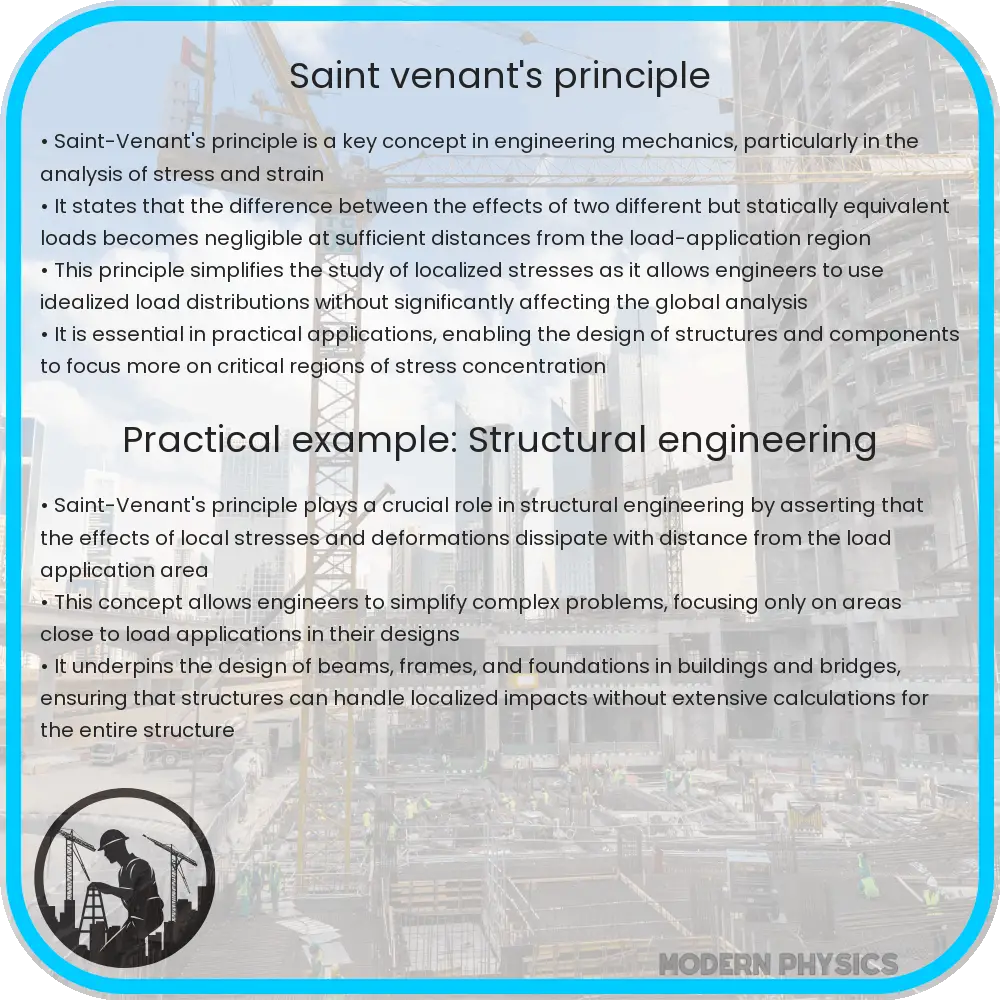Explore Saint-Venant’s Principle in stress analysis, its applications, limitations, and impact on structural engineering and material science.

Understanding Saint-Venant’s Principle in Stress Analysis
Saint-Venant’s Principle is a foundational concept in the field of structural engineering and mechanics, particularly in stress analysis. Named after the French engineer Adhémar Jean Claude Barré de Saint-Venant, this principle provides significant insights into how loads applied to a structure are distributed and how they affect stress within the material. Understanding this principle is crucial for engineers and designers in predicting the behavior of structures under various loading conditions.
What is Saint-Venant’s Principle?
At its core, Saint-Venant’s Principle asserts that the stress distribution in an elastic body will be approximately the same for two different but statically equivalent loadings, provided the loadings are applied over sufficiently small regions and at a sufficient distance from the point of interest. This means that for a large structure, the precise distribution of stress near the point of load application becomes less significant at points far away from where the load is applied. The principle essentially allows for a simplification in the analysis of stress and strain in structures.
Applications and Implications
The principle is widely used in engineering to simplify complex problems. For instance, when calculating the stress in a beam under a load, engineers can often model the load as a single force or moment, without needing to consider the actual, possibly complex, distribution of that load over the beam’s surface. This simplification is especially helpful in the early stages of design and analysis.
However, it is important to understand the limitations of Saint-Venant’s Principle. The approximation it provides becomes less accurate near the area of load application and is not suitable for analyzing stresses at points close to where the load is applied. Therefore, while it simplifies calculations for certain areas of a structure, it does not replace the need for detailed analysis in critical sections.
Mathematical Formulation
In mathematical terms, Saint-Venant’s Principle can be expressed through various equations in solid mechanics. For example, in the analysis of beams, the bending moment \( M \) and shear force \( V \) are often used to approximate stress using the formulas:
- \( \sigma = \frac{M \cdot y}{I} \) (for bending stress, where \( \sigma \) is the stress, \( M \) is the bending moment, \( y \) is the distance from the neutral axis, and \( I \) is the moment of inertia)
- \( \tau = \frac{V \cdot Q}{I \cdot b} \) (for shear stress, where \( \tau \) is the shear stress, \( V \) is the shear force, \( Q \) is the first moment of area, and \( b \) is the breadth of the section perpendicular to the shear)
These formulas, while based on simplifications provided by Saint-Venant’s Principle, allow for effective and efficient stress analysis in many structural engineering scenarios.
Deeper Insights into Saint-Venant’s Principle
The effective application of Saint-Venant’s Principle extends beyond mere simplifications. It plays a crucial role in the design of experiments and simulations in material science and engineering. By acknowledging that the effects of stress concentration diminish at distances, engineers can focus on the more critical aspects of design, such as fatigue life, fracture points, and overall structural integrity.
This principle also aids in understanding and predicting the behavior of materials under different loading conditions. For example, in finite element analysis (FEA), a popular computational tool in engineering, Saint-Venant’s Principle allows for the modeling of complex structures with reasonable accuracy without having to simulate every detail of the loading conditions.
Limitations and Considerations
While Saint-Venant’s Principle is a powerful tool, it is not without its limitations. The principle holds true primarily for materials that exhibit linear-elastic behavior. In materials that exhibit plastic deformation, viscoelasticity, or other non-linear behaviors, the principle may not accurately predict the stress distribution. Additionally, the principle assumes that the load is applied gradually and remains static, which may not always be the case in real-world scenarios.
Another consideration is the scale of application. The principle is more applicable in macro-scale structures and may not hold as accurately at the micro or nano-scale, where material properties can differ significantly from bulk properties.
Conclusion
In conclusion, Saint-Venant’s Principle is a cornerstone in the field of structural analysis, providing a fundamental understanding of how stresses are distributed in elastic bodies under various loading conditions. While it offers significant simplifications and is immensely useful in engineering applications, its limitations must be understood and accounted for. It serves as a reminder that while simplifications are useful in engineering, they must be applied judiciously and in the right context. As materials and analysis techniques continue to evolve, Saint-Venant’s Principle remains a key concept, guiding engineers in designing safer, more efficient structures and components.
Ultimately, Saint-Venant’s Principle is not just a mathematical formulation but a concept that bridges theory and practical application, highlighting the importance of understanding the underlying physics and mechanics in engineering design and analysis.
